#data types in java
Explore tagged Tumblr posts
Text
I've been depressed the last couple of weeks so I decided to watch an Bee and Puppy Cat and please tell me why I saw Java snippet of subtracting and adding to the digits of Pi???
I kind find interesting they decided to write in Java, which is a multi platform language well known and stablished in the Industr and who is Jackson Nathan???
#bee and puppycat#i noticed syntax error and data types misha dling but you know#but i mean its a cartoon about a little robot and a intergalactic cat taking temp jobs#so it wasnt like i was expecting accuracy so it was a pleasant surprise#interesting choice using java of all laguages#it would be a good idea to learn java#but im barely holding it together with Python and JavaScript#they work well for me in the meantime#maybe in the future
2 notes
·
View notes
Text
Very amused every time someone discovers the ultimate way to do OOP in its truest, most polymorphic, most object-oriented form and its just immutable classes with public instance variables and no methods and no inheritance being transformed through singleton classes with no instance variables and one side-effect-free method, potentially taking a function as a parameter or returning another single method class. Brother you just reinvented functional programming.
#codeblr#progblr#object oriented programming#OOP#functional programming#Algebraic data types. Pure functions. Higher order functions. Closures. The gangs all here#And then whenever you tell them that what they did. they say its like functional programming but different because its polymorphic#Literally had a conniption when robert martin said he discovered clojure was actually an oop language because#it was better at polymorphism than java#This is without knowing the subtype polymorphic features in clojure
4 notes
·
View notes
Text
#AI#BigData#CloudComputing#DataAnalytics#DataPlatforms#DataScience#IoT#IIoT#PyTorch#Python#RStats#TensorFlow#Java#JavaScript#ReactJS#GoLang#Serverless#4 types of data analytics#analytics#aws iot analytics#big data#big data analytics#data analysis#data analytics#data analytics career#data analytics job#data analytics project#data analytics roadmap#data analytics trends#data handling in iot
0 notes
Text

TECHNOLOGY ID PACK

NAMES︰ admin. ajax. alexa. am. atari. audio. auto. bailey. binary. blank. blu. blue. bluesse. browser. browsette. bug. byte. cache. calware. chip. circe. click. clicker. clickie. clicky. cloud. coda. code. codette. codie. cody. computette. crypt. cursor. cy. cyber. cybernet. cybernetica. cyberweb. cypher. cypherre. data. dell. digi. digitalia. digitelle. digitesse. disc. dot. electronica. electronique. emoticon. emoticonnie. fax. file. gig. gizmo. glitch. glitche. glitchesse. glitchette. graphique. hacker. hal. halware. hijack. index. informationne. intelligette. internette. interweb. java. javascript. juno. key. link. linuxe. lotus. lovebytes. mac. mal. malakai. malware. malwaria. memorette. memorie. meta. mic. micah. mickey. morphe. mouse. mousette. myspace. nano. neo. net. netette. nett. netty. paige. pascal. payton. peyton. pixel. programatha. programette. programme. pulse. reboot. rom. router. ruby. sam. sammy. screene. screenette. sean. shock. solitaire. spy. static. stutter. talia. tap. tecca. tech. techette. tessa. tetris. trojan. troubleshoot. ts. user. vir. virus. virusse. volt. vyrus. webbe. wheatley. whirr. widget. will. wirehead. wiresse. zap. zett. zetta. zip.

PRONOUNS︰ ai/ai. alt/alt. anti/antivirus. arc/archive. audio/audio. bat/battery. beep/beep. beep/boop. bit/bit. bit/byte. blue/blue. board/board. bright/bright. brow/browser. browser/browser. brr/brr. bu/bug. bug/bug. buzz/buzz. byt/byte. byte/byte. c/cpu. charge/charger. cir/circuit. cli/click. click/clack. click/click. click/scroll. co/code. code/code. color/color. com/com. com/computer. comp/computer. compute/computer. computer/computer. cor/corrupt. corrupt/corrupt. CPU/CPU. crash/crash. cre/creeper. crtl/crtl. cy/cyber. cyb/cyber. cyber/cyber. da/data. data/data. delete/delete. di/disk. dig/digital. digi/digi. digi/digital. digital/digital. dra/drag. e/exe. electronic/electronic. enter/enter. er/error. err/error. error/error. exe/exe. fi/file. file/file. gi/gif. gli/glitch. glit/glitch. glitch/glitch. graphic/graphic. hac/hacker. hack/hack. hard/hardware. head/phone. hij/hijacker. ho/home. info/info. information/information. int/internet. intelligent/intelligence. intelligent/intelligent. inter/net. internet/internet. it/it. jpg/jpg. key/board. key/cap. key/key. key/keyboard. key/keylogger. lag/lag. lap/laptop. ligh/light. linux/linux. load/load. log/login. main/mainframe. mal/malware. me/media. memory/memorie. mon/monitor. mou/mouse. nano/nano. net/net. net/network. org/org. over/overwrite. page/page. pix/pix. pix/pixel. pixel/pixel. plu/plug. png/png. pop/popup. port/port. pow/power. pro/program. program/program. ram/ram. ran/ransom. reboot/reboot. reload/reload. res/restore. ret/retro. route/router. sca/scan. scr/scroll. scre/screen. scre/screencap. scree/screen. screen/screen. scri/script. script/script. sentient/sentience. shift/shift. site/site. skip/skip. soft/software. spa/spam. space/space. spy/spyware. stop/stop. te/tech. tech/nology. tech/tech. technology/technology. tou/touchpad. txt/txt. typ/type. upload/upload. user/user. vi/viru. vi/virus. vir/virtual. web/page. web/web. whir/whir. wi/wire. win/dow. win/window. wire/wire. wire/wired. zip/zip . ⌨ . ☣ . ⚙ . ⚠ . 🎞 . 🎨 . 🎭 . 🎮 . 🎵 . 👀 . 👁 . 💔 . 💡 . 💢 . 💣 . 💳 . 💵 . 💻 . 💽 . 💾 . 💿 . 📀 . 📱 . 🔇 . 🔈 . 🔉 . 🔊 . 🔋 . 🔌 . 🔎 . 🖥 . 🖱 . 🗡 . 🗯 . 🛠 . 🧿 .

#pupsmail︰id packs#id pack#npt#name suggestions#name ideas#name list#pronoun suggestions#pronoun ideas#pronoun list#neopronouns#nounself#emojiself#techkin#robotkin#internetkin
453 notes
·
View notes
Text


I tried to make something since Animation vs Coding came out. (I don't care about misspelling.)
This is a joke with no punch line because, while it is certainly in-character to these 2 terrorists, it is not a joke I am committed to make. I hope you don't even know what codes they are reacting to.
So, now the punchline is... Everything is so bad from the ground-up, The Dark Lord doesn't know where to start? And The Chosen One somehow ended up insulting ONE normal thing, enraging TDL? Good enough.
I thought about deleting the entire thing, but it was such a perfect way to showcase that me, the author, can "play" a character who much more knowledgeable than I am, because I don't code.
(I don't code beyond getting a bad grade in basic Java and superficially studied C, C++ and C# just to make my resume more attractive. I got my job, I don't care.)
I didn't even know what is an "Enum" before making this comic. Do your research and cherry-pick correct information, and you can fool the average audiences before an actual expert shows up.
One quirk I gave to TCO and TDL (most likely the rest of digital creatures), is that they influenced by the code they speak out loud. TCO has randomized capital letter throughout their speech, but say "Floor" the exact way it appears in code, twice, because string data is case-sensitive. They have free will and can choose not to execute friend certain scripts or simply refuses to say it out loud.
After this, TDL is putting TCO in CODE dot ORG jail. A very great place to start learning, by the way. (Unlike Brilliant, it's free.)
I am explaining things under the cut
You watched AvC, so you already know what is constant and variable... but still;
Gravitational acceleration is a constant.
Speed is a variable.
In your program, you would want some value to change, some to stay the same.
Enum is a type of class.
Class is a collection of data that can either be variables or constant, they can be different data type. Class is good for creating character profile, such as containing both Name (String) and age (Integer).
Enum, is a type of class that only contain constant. If class is a character profile, then, Enum is a lore book that contain things that need to be reference, unchanged, throughout the program. In this comic, Enum is used for items. Unless an upgrade system is involved, items should have the same property.
Me, personally, would simply put name strings in Enum, but actual coding is flexible to make it less of a nightmare to come back and fix, so, as The Dark Lord says, not ideal, but fine.
Not code, PU = Processing Unit, used interchangeably with brain. TDK specifically says that because it sounds like, "Poo".
#animator vs animation#animation vs coding#animation vs education#ava the dark lord#ava the chosen one#sketch#ava/m#avc#ave#ava comic
45 notes
·
View notes
Text




⌗ ⠀brainmade cyborg bah pack ( tw for eyestrain )

✦⠀names ;
︵ cypher, neo, galileo, gibson, jameson, tanner, charles, data, linux, algernon, xanthe, axiom, reece, sampson
✦⠀pronouns ;
︵ hx hxm, thxy thxm, ix ixes, it its, x xs, net nets, cy cys, web webs, tech techs, code codes, site sites, hack hacks, wire wires, bot bots, 01 01s, 404 404s, key keys, click clicks, html htmls, java javas, py pythons, dark darks, shade shades, blood bloods, kill kills, death deaths, stalk stalks, hurt hurts, stab stabs, end ends
✦⠀orientation ;
︵ aromantic, asexual, romance repulsed, sex repulsed, demiplatonic, sinister aromantic
✦⠀gender ;
︵ gendervoid, agender, bloodgender, predatorthing, bloodaesic, fleshthing, robotix, cyborgian, techcoric, chaosthing, genderthreat, viruscoric, violentgender, demonthing, hatergender, daimcuos, unholybodiment,
✦⠀age ;
︵ 1000+ (ageless adult)
✦⠀species ;
︵ demon cyborg
✦⠀kintypes ;
︵ hellhound therian
✦⠀source ;
︵ none
✦⠀typing sample ;
︵ “ I’m not here to be your friend, you understand? I’m here to do my job. That’s it. So don’t go getting all buddy-buddy with me. For both our sakes, just leave me alone. ”
✦⠀roles ;
︵ grudge holder, persecutor-protector, anger manager, malicitor
✦⠀personality ;
︵ cypher has a short temper and an unpleasant disposition. hx’s a demon of very few words, unless you really piss hxm off. hx prefers to spend time alone, obsessing over all the ways the system has been wronged in the past. hx will find any reason hx can to push the system’s friends away, viewing anyone and everyone (even hxs headmates) as a threat.
✦⠀likes ;
︵ justice, being left alone, action movies, yelling at people
✦⠀dislikes ;
︵ pretty much everything and everyone
✦⠀hobbies ;
︵ brooding
✦⠀faceclaims ;




@thewolvenpacks
#( 🫧 ) order up!#baa pack#bah pack#build a headmate#build an alter#alter creation#alter inspo#alter packs#create a headmate#headmate pack#headmate creation#headmate inspo#create an alter#tw eyestrain#eyestrain
29 notes
·
View notes
Text

✰ wonwoo x gn. reader ; fluff ; 0.6k

Wonwoo's blue full-sleeved shirt was curry-stain free and worn the proper way. He smells of freshly washed linen and breath mints. The weather is perfect, warm rays of sunshine spreading across a cloudless sky (he carried an umbrella nonetheless).
So far so good. Grade B, even.
Today is the day Wonwoo would try and catch the seat next to you in the Environmental Technology elective you both took. Maybe strike a colloquy with you on environmental toxicology. Maybe even exchange numbers.
“You’ve been saying the same thing for the past three weeks.”
“But-” Wonwoo stops, frowning at the notification on his phone. Soonyoung glances over his shoulder to take a look. The former sighs. The latter doesn’t bother to conceal his laugh.
Wonwoo had run a lot of scenarios through his head, finding appropriate solutions for each case. Nothing however would have prepared him for the class getting cancelled today.
“On the brighter side, you can practice your pick up lines on yourself for another day.” Soonyoung clears his throat to match Wonwoo's voice, “are you a data type? because you float inside my mind.”
Soonyoung sidesteps, avoiding the jab coming his way. He backpedals away, mouthing better luck next time as he leaves for his next class before the “Shut up.” leaves Wonwoo's lips.
And that’s how he ends up in the library, trying to finish his assignment for the OOP using Java bridge course. The key word is trying; there’s only so much freecodecamp.org can help with. He twirls his pencil around his thumb. Today was a failure. Maybe he should quit this and visit that new boba place instead.
“Hey, Wonwoo.”
The pencil falls from his hand and onto the floor. Wonwoo looks up to face you. Milliseconds pass by as he digests the fact that you did, indeed, call him.
He likes the sound of his name on your lips.
You pick his pencil up for him, a smile adorning your face as you continue, "I'm-
-(name)”, fuck, what happened to his lower register? “I've seen you around. We share the environmental technology class.”
It all comes out at a pace too fast for his liking, but you nod along. Wonwoo takes his pencil from your outstretched hand, mumbling thanks and trying not to hyperfixate on how his fingers would've brushed yours had he moved them a little closer. Cerise colours his ears at the thought.
You glance at the material strewn across the table, recognition flashing across your face. "I took this course last sem." Your eyes shift to his laptop's screen, which currently flashes a runtime error.
Of all times, why now?
He follows your gaze, feeling sheepish. "Well, this course is not for the weak."
You snort in agreement. "So, want some help debugging?"
"Oh please."
Wonwoo knew he should be paying attention to what you were doing but trying not to hyperfixate is easier said than done. '(name) pulled a chair right next to you to help you', chanted a little voice in the back of his head. From the spark in your eyes and the furrow of your eyebrows to the shade of your currently pursed lips, he couldn't help but notice it all.
This is nice.
"I'm done."
Wonwoo blinks. Already? He looks at the screen and then at you in awe. "That was really fast. Thank you."
Your smile widens. You move your chair and sling your bag over your shoulder, getting ready to leave. "Let me know if you need help with anything else."
It was now or never.
"Are you free for a boba run? it's on me."
One second. Two. Three. He shouldn't have-
-sure. Should we check out the new place downtown?"
"Yes." Yes, anything you say. He stuffs his bag with his books.
Maybe, today deserves a solid grade A.

#.jww#seventeen scenarios#wonwoo x reader#wonwoo x you#wonwoo x y/n#seventeen fluff#wonwoo fluff#wonwoo scenarios#seventeen imagines#seventeen x reader#wonwoo imagines
186 notes
·
View notes
Text
the three types of programmer job posting in 2025:
we need someone with strong problem solving skills and a knowledge of C/C++ Python and Java who enjoy challenging. experience with bash scripts a plus
we need a CI/CD Spring Boot Agile DevOps test engineer with Jira fast-paced weekends start immediately 5 years experience required no degree
we need a react/node.js html/css c# typescript webdev who also knows python oh god why does no one in webdev understand basic data structures
7 notes
·
View notes
Text
November 15th Journal Song of the day - Illicit Affairs (Taylor Swift)

It's been getting too cold to go out and work/study, so I've been making a cozier home office space. It wasn't too bad yesterday, so I went downtown and did anything I could there. Work has been unbelievably busy, to the point where I'm working at 1 AM despite having a 9-5. I wanted to feel needed at work- I got what I wanted and here we are now. I haven't been able to even attempt any extra studying, but things should slow down for a bit so I'm back at it. To-do: Habit 1: Studying 🦉Plan how to re-create my current portfolio 🦉Data Analysis Assignment Unit 3 🦉Data Analysis 5.1 🦉Type out more handwritten notes 🦉Python Coursera Final Project 🦉Python CS50 Lect 1 Projects Habit 2: Self-care 🕯️30-minute home workout 🕯️A bottle of water 🕯️Scrapbook a page Habit 4: Reading 📰100 pages of the 5 AM Club (Robin Sharma) 📰Ch 1 of Java script book Habit 5: Language Learning 🏛️Italian level 1
#studyblr#studyspo#study motivation#daily journal#to do list#light academia#study blog#coding#dark academia#langauge learning#workblr#langblr#it girl self care#becoming that girl#journaling#journal
14 notes
·
View notes
Note
As the person I follow who does reverse engineering, do you have any suggestions for finding resources on reverse engineering Android apps?
Specifically, there's an app I'm playing with, where after seeing the structure of the "export as Markdown" output I want to know what the internal structure and representation of the data is. The end goal of understanding it is to be able to add certain kinds of data dynamically, rather than up front. That's certainly doable typing in raw markdown, but being able to do it "app style" would be more convenient.
The google Play Store entry does not mention any open source licenses, or looking for the source code and hopefully a git repo or something would have been my first step.
(I'll probably need to bang together a crappy app to do what I really want regardless, but maybe this app's data structure would be more convenient than doing so with markdown.)
So, android stuff:
First you need the APK. You can do some trickery with your phone to pull it over the ADB connection if you install the android SDK, but generally I just google "app name APK" and you'll find some greymarket site that'll give you a copy.
Secondly, APKs are just ZIP files (JAR files, technically, but JAR files are also just ZIP files!). Unzip them and you can find lots of interesting stuff, often.

For disassembling/decompiling them, my go-to program is jadx. It's a java decompiler that's been around a while and can natively open APK files and decompile them. There's some weirder new APKs that it can't handle (something to do with a newer bytecode revision, I think?) but I can't recall the details on how you handle those. Those are rare, in my experience. jadx is pretty good, but you'll occasionally find methods or entire classes that it just can't figure out, and it'll give you a bytecode dump. I don't yet have a good solution for those, other than "get good at reading JVM bytecode".
If you're dealing with games, another useful thing can be UABE and dotPeek. These are unity/C# tools, but you would be surprised how many android games (and non-games!) are actually unity under the hood.
Bluestacks can also be useful, because it'll let you run the app on your desktop and that can be handy for things like running WireShark to log all network traffic.
Speaking of logging, the other handy thing I've done is enabling android developer mode on my phone to get to one specific option: Bluetooth HCI snoop log.
Now, actually getting that log is tricky and varies from phone to phone, because for some reason manufacturers like to move it around, but it's one of the best ways to reverse engineer bluetooth communication stuff. You basically turn on the log and everything your phone does to communicate with your Smart Toothbrush or whatever will be logged to a file, then you can yank that file over and stuff it into Wireshark.
So... hopefully some of that is a helpful start? I've not done a huge amount of Android reversing so I'm not super familiar with the tools used, but these are the ones I've got on hand for when I do.
also sorry for all the horny robotgirl posters who saw "android reverse engineering" in the tags and thought this was gonna be about taking them apart with screwdrivers and rooting around in their insides. Not today!
108 notes
·
View notes
Text
The C Programming Language Compliers – A Comprehensive Overview
C is a widespread-purpose, procedural programming language that has had a profound have an impact on on many different contemporary programming languages. Known for its efficiency and energy, C is frequently known as the "mother of all languages" because many languages (like C++, Java, and even Python) have drawn inspiration from it.
C Lanugage Compliers

Developed within the early Seventies via Dennis Ritchie at Bell Labs, C changed into firstly designed to develop the Unix operating gadget. Since then, it has emerge as a foundational language in pc science and is still widely utilized in systems programming, embedded systems, operating systems, and greater.
2. Key Features of C
C is famous due to its simplicity, performance, and portability. Some of its key functions encompass:
Simple and Efficient: The syntax is minimalistic, taking into consideration near-to-hardware manipulation.
Fast Execution: C affords low-degree get admission to to memory, making it perfect for performance-critical programs.
Portable Code: C programs may be compiled and run on diverse hardware structures with minimal adjustments.
Rich Library Support: Although simple, C presents a preferred library for input/output, memory control, and string operations.
Modularity: Code can be written in features, improving readability and reusability.
Extensibility: Developers can without difficulty upload features or features as wanted.
Three. Structure of a C Program
A primary C application commonly consists of the subsequent elements:
Preprocessor directives
Main function (main())
Variable declarations
Statements and expressions
Functions
Here’s an example of a easy C program:
c
Copy
Edit
#include <stdio.H>
int important()
printf("Hello, World!N");
go back zero;
Let’s damage this down:
#include <stdio.H> is a preprocessor directive that tells the compiler to include the Standard Input Output header file.
Go back zero; ends this system, returning a status code.
4. Data Types in C
C helps numerous facts sorts, categorised particularly as:
Basic kinds: int, char, glide, double
Derived sorts: Arrays, Pointers, Structures
Enumeration types: enum
Void kind: Represents no fee (e.G., for functions that don't go back whatever)
Example:
c
Copy
Edit
int a = 10;
waft b = three.14;
char c = 'A';
five. Control Structures
C supports diverse manipulate structures to permit choice-making and loops:
If-Else:
c
Copy
Edit
if (a > b)
printf("a is more than b");
else
Switch:
c
Copy
Edit
switch (option)
case 1:
printf("Option 1");
smash;
case 2:
printf("Option 2");
break;
default:
printf("Invalid option");
Loops:
For loop:
c
Copy
Edit
printf("%d ", i);
While loop:
c
Copy
Edit
int i = 0;
while (i < five)
printf("%d ", i);
i++;
Do-even as loop:
c
Copy
Edit
int i = zero;
do
printf("%d ", i);
i++;
while (i < 5);
6. Functions
Functions in C permit code reusability and modularity. A function has a return kind, a call, and optionally available parameters.
Example:
c
Copy
Edit
int upload(int x, int y)
go back x + y;
int important()
int end result = upload(3, 4);
printf("Sum = %d", result);
go back zero;
7. Arrays and Strings
Arrays are collections of comparable facts types saved in contiguous memory places.
C
Copy
Edit
int numbers[5] = 1, 2, three, 4, five;
printf("%d", numbers[2]); // prints three
Strings in C are arrays of characters terminated via a null character ('').
C
Copy
Edit
char name[] = "Alice";
printf("Name: %s", name);
8. Pointers
Pointers are variables that save reminiscence addresses. They are powerful but ought to be used with care.
C
Copy
Edit
int a = 10;
int *p = &a; // p factors to the address of a
Pointers are essential for:
Dynamic reminiscence allocation
Function arguments by means of reference
Efficient array and string dealing with
9. Structures
C
Copy
Edit
struct Person
char call[50];
int age;
;
int fundamental()
struct Person p1 = "John", 30;
printf("Name: %s, Age: %d", p1.Call, p1.Age);
go back 0;
10. File Handling
C offers functions to study/write documents using FILE pointers.
C
Copy
Edit
FILE *fp = fopen("information.Txt", "w");
if (fp != NULL)
fprintf(fp, "Hello, File!");
fclose(fp);
11. Memory Management
C permits manual reminiscence allocation the usage of the subsequent functions from stdlib.H:
malloc() – allocate reminiscence
calloc() – allocate and initialize memory
realloc() – resize allotted reminiscence
free() – launch allotted reminiscence
Example:
c
Copy
Edit
int *ptr = (int *)malloc(five * sizeof(int));
if (ptr != NULL)
ptr[0] = 10;
unfastened(ptr);
12. Advantages of C
Control over hardware
Widely used and supported
Foundation for plenty cutting-edge languages
thirteen. Limitations of C
No integrated help for item-oriented programming
No rubbish collection (manual memory control)
No integrated exception managing
Limited fashionable library compared to higher-degree languages
14. Applications of C
Operating Systems: Unix, Linux, Windows kernel components
Embedded Systems: Microcontroller programming
Databases: MySQL is partly written in C
Gaming and Graphics: Due to performance advantages
2 notes
·
View notes
Note
Any tips on learning python? I already know Java, C++, and JavaScript.
Hiya! 💗
Since you already know those other languages, Python will be literally a piece of cake. It'll be easy for you, in my opinion.
Tips? I would say:
Start with the Basics: Begin by understanding the fundamental syntax and concepts of Python. After learning those, you can basically apply the languages you know logic into Python code and you'll be done. You can use online tutorials on YouTube or free online pdf books to get a good grasp of the basics.
Leverage Your Programming Experience:Like I mentioned Python shares similarities with many languages, so relate Python concepts to what you already know. For example, understand Python data types and structures in comparison to those in Java, C++, or JavaScript.
Projects and Practice:I sing this on my blog but practice is crucial. Start small projects or challenges to apply your Python knowledge. Depends what you want to build e.g. console apps, games, websites etc. Just build something small every so often!
Hope this helps! More tips I made: ask 1 | project ideas | random resources

⤷ ♡ my shop ○ my mini website ○ pinned ○ navigation ♡
#my asks#codeblr#coding#progblr#programming#studying#studyblr#learn to code#comp sci#tech#programmer#python#resources#python resources
29 notes
·
View notes
Text
Mastering Data Structures: A Comprehensive Course for Beginners
Data structures are one of the foundational concepts in computer science and software development. Mastering data structures is essential for anyone looking to pursue a career in programming, software engineering, or computer science. This article will explore the importance of a Data Structure Course, what it covers, and how it can help you excel in coding challenges and interviews.
1. What Is a Data Structure Course?
A Data Structure Course teaches students about the various ways data can be organized, stored, and manipulated efficiently. These structures are crucial for solving complex problems and optimizing the performance of applications. The course generally covers theoretical concepts along with practical applications using programming languages like C++, Java, or Python.
By the end of the course, students will gain proficiency in selecting the right data structure for different problem types, improving their problem-solving abilities.
2. Why Take a Data Structure Course?
Learning data structures is vital for both beginners and experienced developers. Here are some key reasons to enroll in a Data Structure Course:
a) Essential for Coding Interviews
Companies like Google, Amazon, and Facebook focus heavily on data structures in their coding interviews. A solid understanding of data structures is essential to pass these interviews successfully. Employers assess your problem-solving skills, and your knowledge of data structures can set you apart from other candidates.
b) Improves Problem-Solving Skills
With the right data structure knowledge, you can solve real-world problems more efficiently. A well-designed data structure leads to faster algorithms, which is critical when handling large datasets or working on performance-sensitive applications.
c) Boosts Programming Competency
A good grasp of data structures makes coding more intuitive. Whether you are developing an app, building a website, or working on software tools, understanding how to work with different data structures will help you write clean and efficient code.
3. Key Topics Covered in a Data Structure Course
A Data Structure Course typically spans a range of topics designed to teach students how to use and implement different structures. Below are some key topics you will encounter:
a) Arrays and Linked Lists
Arrays are one of the most basic data structures. A Data Structure Course will teach you how to use arrays for storing and accessing data in contiguous memory locations. Linked lists, on the other hand, involve nodes that hold data and pointers to the next node. Students will learn the differences, advantages, and disadvantages of both structures.
b) Stacks and Queues
Stacks and queues are fundamental data structures used to store and retrieve data in a specific order. A Data Structure Course will cover the LIFO (Last In, First Out) principle for stacks and FIFO (First In, First Out) for queues, explaining their use in various algorithms and applications like web browsers and task scheduling.
c) Trees and Graphs
Trees and graphs are hierarchical structures used in organizing data. A Data Structure Course teaches how trees, such as binary trees, binary search trees (BST), and AVL trees, are used in organizing hierarchical data. Graphs are important for representing relationships between entities, such as in social networks, and are used in algorithms like Dijkstra's and BFS/DFS.
d) Hashing
Hashing is a technique used to convert a given key into an index in an array. A Data Structure Course will cover hash tables, hash maps, and collision resolution techniques, which are crucial for fast data retrieval and manipulation.
e) Sorting and Searching Algorithms
Sorting and searching are essential operations for working with data. A Data Structure Course provides a detailed study of algorithms like quicksort, merge sort, and binary search. Understanding these algorithms and how they interact with data structures can help you optimize solutions to various problems.
4. Practical Benefits of Enrolling in a Data Structure Course
a) Hands-on Experience
A Data Structure Course typically includes plenty of coding exercises, allowing students to implement data structures and algorithms from scratch. This hands-on experience is invaluable when applying concepts to real-world problems.
b) Critical Thinking and Efficiency
Data structures are all about optimizing efficiency. By learning the most effective ways to store and manipulate data, students improve their critical thinking skills, which are essential in programming. Selecting the right data structure for a problem can drastically reduce time and space complexity.
c) Better Understanding of Memory Management
Understanding how data is stored and accessed in memory is crucial for writing efficient code. A Data Structure Course will help you gain insights into memory management, pointers, and references, which are important concepts, especially in languages like C and C++.
5. Best Programming Languages for Data Structure Courses
While many programming languages can be used to teach data structures, some are particularly well-suited due to their memory management capabilities and ease of implementation. Some popular programming languages used in Data Structure Courses include:
C++: Offers low-level memory management and is perfect for teaching data structures.
Java: Widely used for teaching object-oriented principles and offers a rich set of libraries for implementing data structures.
Python: Known for its simplicity and ease of use, Python is great for beginners, though it may not offer the same level of control over memory as C++.
6. How to Choose the Right Data Structure Course?
Selecting the right Data Structure Course depends on several factors such as your learning goals, background, and preferred learning style. Consider the following when choosing:
a) Course Content and Curriculum
Make sure the course covers the topics you are interested in and aligns with your learning objectives. A comprehensive Data Structure Course should provide a balance between theory and practical coding exercises.
b) Instructor Expertise
Look for courses taught by experienced instructors who have a solid background in computer science and software development.
c) Course Reviews and Ratings
Reviews and ratings from other students can provide valuable insights into the course’s quality and how well it prepares you for real-world applications.
7. Conclusion: Unlock Your Coding Potential with a Data Structure Course
In conclusion, a Data Structure Course is an essential investment for anyone serious about pursuing a career in software development or computer science. It equips you with the tools and skills to optimize your code, solve problems more efficiently, and excel in technical interviews. Whether you're a beginner or looking to strengthen your existing knowledge, a well-structured course can help you unlock your full coding potential.
By mastering data structures, you are not only preparing for interviews but also becoming a better programmer who can tackle complex challenges with ease.
3 notes
·
View notes
Text
Chapter 43- Part 7
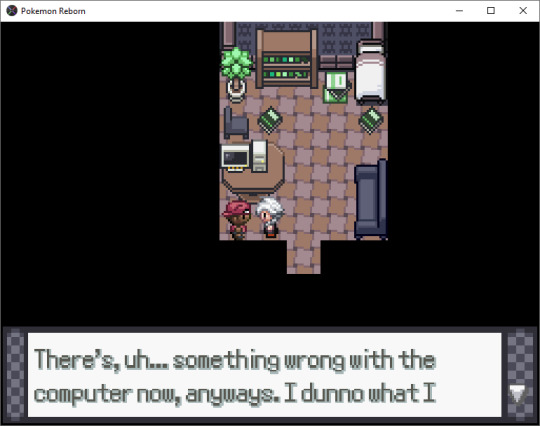



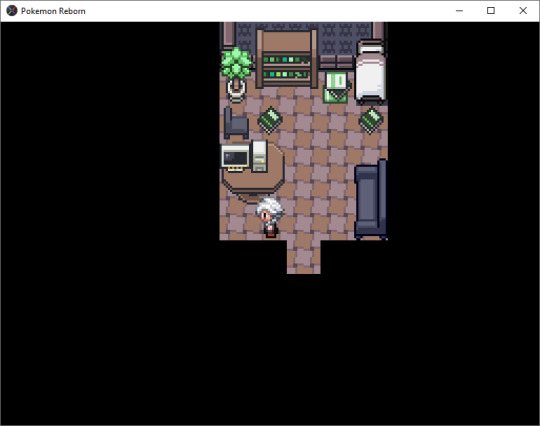
Okay, that was step one, step two- time to make things even worse for this computer!



Oh, not even a “Yes” or “No” prompt? Just…goes automatically? Yeesh, imagine if someone with a Data Chip triggered this event by accident-
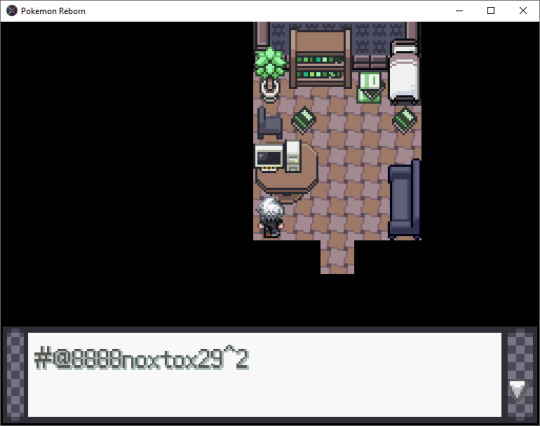

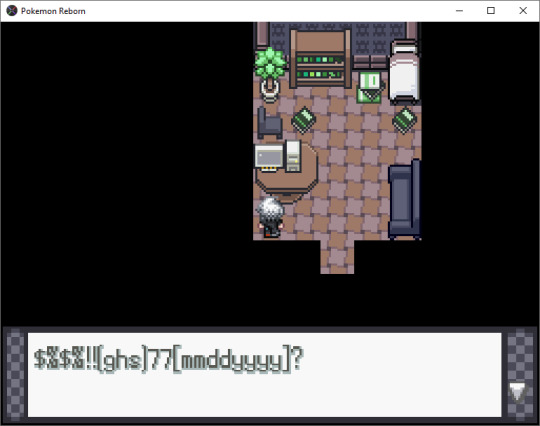
Yeah, yup, mm-hm, this is how my laptop acts on a daily basis, this is definitely normal.


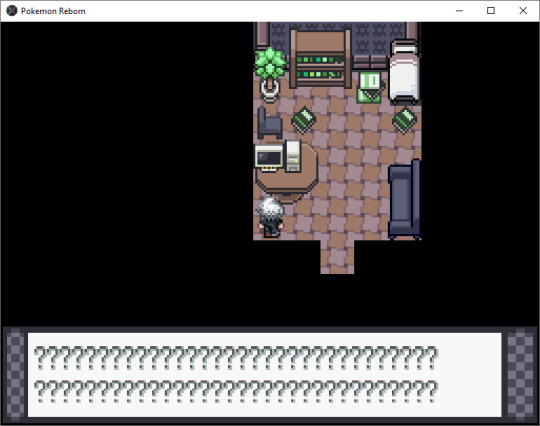
Me too, computer.

GAH, WHAT THE-!? PORYGON WHY DID YOU GLITCH THE WORLD!?
Soooo, uuuh…yeah, that's the last encounter for right now! Porygon! I love Porygon, those who follow my blog should know this, I have a whole tag dedicated to appreciation of Porygon, but I am still very terrified of…whatever this glitchy Field is!
Okay, okay, let's just…take it slow, and start by paralyzing it like usual.
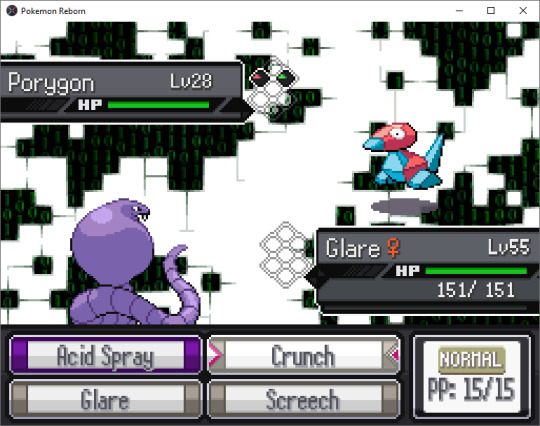
That's…just not correct…

But anyways, Glare™ was successful, so let's just try our first Ball? I don't feel comfortable using any moves on it lest I risk knocking it out, so…
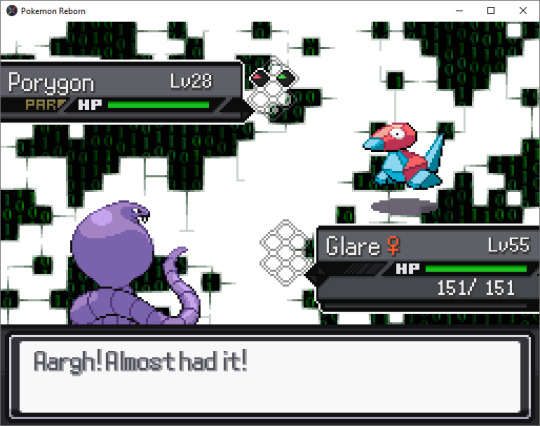
NO, THAT WAS MY LUXURY BALL TOO! Now I have to use a boring ol’ Great Ball!
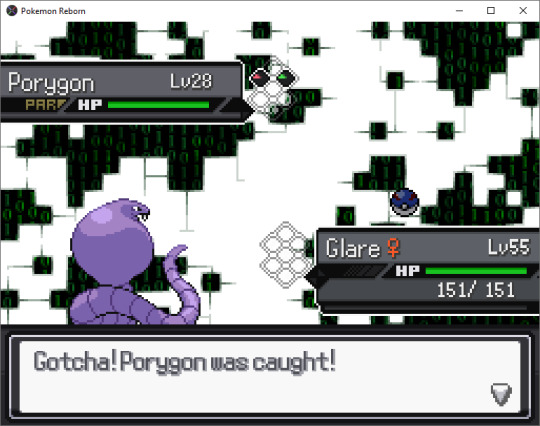

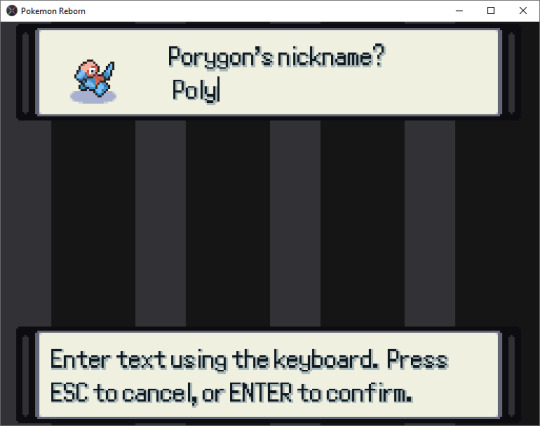
My first idea was to name it after some kinda coding language, but considering how…quirky some of them are (like- Java, Python, c'mon this guy deserves better than that), I just decided to name it after polygons. I've been rapid-firing these nicknames all day, my brain is becoming more deep-fried by the minute, cut me some slack.
Now, the last thing I wanna check is that new Department Store floor. According to the elevator lady, it's got type effectiveness Berries- but does it have all of them?




Yes they do! Oh, this is so great, I'll definitely have to keep this in mind for future battles, I don't care how expensive these fruits are they are useful! What say you, nameless woman?


I'd like some Berry Trees too, honestly- I just like running around watering and picking Berries from them, that was like a good chunk of the time I spent in Brilliant Diamond.
Alright, I'm satisfied with that, so it's time to get ready for Noel...again. I already discussed my theories and plans for him, but just in case you forgot (and it’s been a few chapters, so I wouldn’t blame you), here's the summarized version:
I already know Noel is gonna have a Clefable, so the other most likely candidates for his team are: Furret, Sawsbuck, Kangaskhan, Kecleon, Blissey, Pyroar, and/or Bewear.
Normal-types are only weak to Fighting, Ghost-types are immune to them and Rock- and Steel-types resist them, not to mention Grassy Terrain provides a boost to both Grass- and Fire-type attacks.
I’m bringing Riptide because he’s the partner Pokémon, Glare for Intimidate support, Bloom for the Growth boost and potential to do big special damage, Wulfrum for the quad resistance to Normal and as a possible Clefable counter, Vulcan as the designated Fighting-type and for the Field’s Fire attack boost, and Jack as the designated Ghost-type and for the Field’s Grass attack boost (on the physical side this time).
Got all that? Great, let's get the team back together! And…huh…

Wasn't that Thick Fat before? I mean Reckless is more accurate, that's what Emboar’s Hidden Ability is supposed to be, fair enough, but still- huh.
Anyways, team's back together:
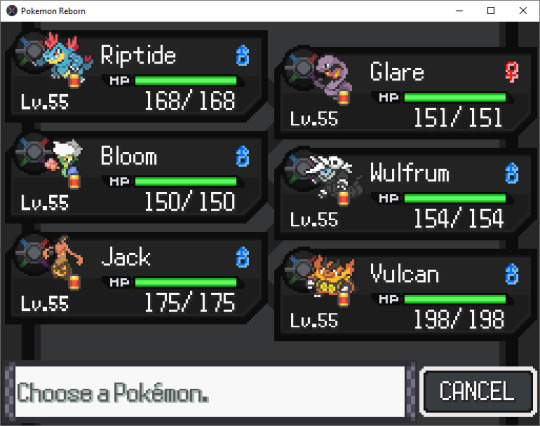
Same items, Wulfrum with the Zoom Lens, Jack with the Elemental Seed, Vulcan with the Charcoal.

Also it's snowing again, that'll be fun to deal with. No, I'm not going to change the weather to something more advantageous for Xera, I'm only gonna use it for static Pokémon encounters.
Previous
Next
3 notes
·
View notes
Text
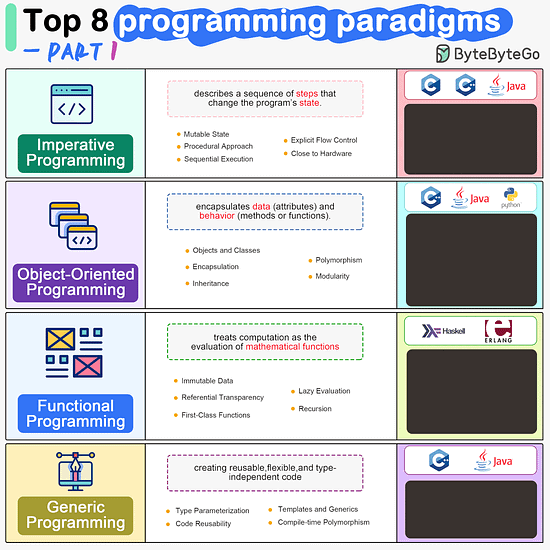
ByteByteGo | Newsletter/Blog
From the newsletter:
Imperative Programming Imperative programming describes a sequence of steps that change the program’s state. Languages like C, C++, Java, Python (to an extent), and many others support imperative programming styles.
Declarative Programming Declarative programming emphasizes expressing logic and functionalities without describing the control flow explicitly. Functional programming is a popular form of declarative programming.
Object-Oriented Programming (OOP) Object-oriented programming (OOP) revolves around the concept of objects, which encapsulate data (attributes) and behavior (methods or functions). Common object-oriented programming languages include Java, C++, Python, Ruby, and C#.
Aspect-Oriented Programming (AOP) Aspect-oriented programming (AOP) aims to modularize concerns that cut across multiple parts of a software system. AspectJ is one of the most well-known AOP frameworks that extends Java with AOP capabilities.
Functional Programming Functional Programming (FP) treats computation as the evaluation of mathematical functions and emphasizes the use of immutable data and declarative expressions. Languages like Haskell, Lisp, Erlang, and some features in languages like JavaScript, Python, and Scala support functional programming paradigms.
Reactive Programming Reactive Programming deals with asynchronous data streams and the propagation of changes. Event-driven applications, and streaming data processing applications benefit from reactive programming.
Generic Programming Generic Programming aims at creating reusable, flexible, and type-independent code by allowing algorithms and data structures to be written without specifying the types they will operate on. Generic programming is extensively used in libraries and frameworks to create data structures like lists, stacks, queues, and algorithms like sorting, searching.
Concurrent Programming Concurrent Programming deals with the execution of multiple tasks or processes simultaneously, improving performance and resource utilization. Concurrent programming is utilized in various applications, including multi-threaded servers, parallel processing, concurrent web servers, and high-performance computing.
#bytebytego#resource#programming#concurrent#generic#reactive#funtional#aspect#oriented#aop#fp#object#oop#declarative#imperative
8 notes
·
View notes
Text
Reawakened; Into the Abyss – Domestic prelude
From my CW final assignment. Every other character belongs to me. This story is 5 pages long in it’s entirety. I feel the need to specify that the 4 characters at the end are Sanrio OC’s and the first 3 are Elemental Alicorns.
🌫️💭🕸️📻🪦🍽️🌑🕳️❔👁️🗨️🕒
Thalassorion laid in a paradise–like island, watching the waves caress the beach. Verdanox and Luxvian suddenly ran over, looking up at their mentor. Thalassorion looked down, “What is it?” “Someone’s at the pizzeria. Appreciate they’re trying to open the pizzeria again.” Verdanox said, “We can’t let them get back in, right?” Luxvian added, standing behind Verdanox. Thalassorion sighed and stood up, walking off with the two running after him like they always did when he had to do something they considered interesting enough to witness for themselves.
Lottie helped Yukio, Taffy, and Winnie off the table in the storage room. Outside the room, near the door, sat Fredbear and Spring Bonnie or Tex, who were busy with a Lego set. “Lego’s really improved.” Fredbear noted, looking at the instructions and trying to find the correct set of pieces being pictured. “We’ve been hidden away for the past 37 years, I think about of things other than Lego have changed.” Tex replied. “My point still stands. These pieces are much more..complicated and intricate. They really improved these models and builds. It’s good but also a bad thing. I mean, this set looks like it’s defying gravity!” “Maybe because these are made for kids and kids din’t exactly know about weight distribution? But I think even kids would be able to realize that these parts aren’t properly supported.” Tex sighed as he waited for his friend to finish.
Nearby, standing outside their large music boxes in a corner, floated Jinx and Marionette. “It’s a bit difficult using pronouns other than the basic trio.” Jinx said. Marionette nodded, “What pronouns do you use?” “Oh, I use he/xi/spir/lumi/pup/jin/clow. What about you?” “He/it/ae/xe/ver/spool/string. I don’t know anybody other than you who uses neopronouns.” “Well, Yukio, Taffy, and Winnie use neopronouns.” Jinx replied as the two now sat in their boxes.
“Oh, really? What neopronouns?” Marionette asked. “From what I remember, Yukio uses he/it/fae/spra/fro/glace/antler/chill/fluff/snow/frost/burr. Taffy uses he/coco/rain/choco/puddle/drip/mochi/raindrop/candy/quack/syrup/melt. Winnie uses she/boo/bubbly/ghost/soapy/lather/phantom/whisp/squeak/froth/fizz/mist/scrub.” Jinx responded. “Do you have this memorized or something?” The other puppet asked.
Jinx disappeared into his box and after some comical sounds came out of the box, he reappeared. He held a Sanrio themed notebook and opened it, flipping through a few pages before showing Marionette a page. “Fredbear uses he/teddy/snugg/cuddly/fuzzy/stuffie/hug/pillow/bearie/fur/paw and Tex uses he/ver/spring/bun/tink, if that’s important to you.” “And Freddy and Bonnie?” “Cutest couple in the company–Anyways, Gabriel uses he/it/xe/fae/bea/sparkle/paw/fluff/bun/pup/hug/ze/ae/confetti/sticker/silly/fun/laugh and Jeremy uses he/ey/vey/byte/data/it/input/output/ram/static/type/java/python/01/exe/bass/chord. And can I also tell you Plushtrap and Carl’s pronouns?” “I know I can’t stop you so..”
“Thanks. Plushtrap uses he/trap/puff/chomp and Carl uses he/cake/sweet/sugar/cherry/flesh/rot/candle.” Jinx responded. “I’ve still got a lot more people to write down. I intend to go for Mangle and Endo next. Also, uh, what were your pronouns again?” He added as he clicked his Sanrio pen. “He/it/ae/xe/ver/spool/string. Also they/them but, like, plural. I just like being referred to as more than one, I dunno.” “Probably Lefty.” “Yeah, I’ll have to get that checked.” Marionette sighed as he pulled out his phone. “I’m scheduling an appointment.”
Plushtrap and Carl sat in a small room, drawing. Plushtrap lifted his drawing. “Look, this is you. You fucking suck, loser.” Carl looked up, showing his own drawing. “Yeah, I drew you too. You’re a dumbass. How accurate.” “The fuck does ‘accurate’ mean?” “Oh my god, you’re actually stupid.” Carl sighed.
Carl looked down and pointed at the sketchpad the other small animatronic had done. “What’s in there?” “Uh, nothing.” Carl raised a brow and suddenly snatched it, running off. Plushtrap yelled and sprinted after him, running past a room where Freddy and Bonnie were inside. Freddy was busy doing a Lego set on a nearby table, struggling to understand how to properly put together a particularly intricate Lego building. “Is is that hard?” Bonnie asked. “Yes. Very.” Freddy sighed in defeat as his close friend walked over “Maybe because you’re not on the right page?” The purple bunny robot muttered as he flipped pages back to the proper page. “Oh!” Freddy said, looking closely at the instructions. “Okay, yeah. Your eyesight got better as an animatronic and mine’s got worse–That’s actually probably karma for me making fun of you being blind, huh? Guess I better start praying to some God above for forgiveness. You think God will forgive it makr me more blind?” “Your eyesight can’t get any worse and the same goes for your memory. You always lose things.” “Like what?” “Your hat.” “It just–” “It is LITERALLY on your head.” “Okay, yeah, well..” Freddy sighed and looked back down to the Lego set.
“Shut up, I’m helping you build your Lego city since Fritz is too busy buying more sets and you know he only helps with it involves vehicles.” Freddy said as he finished making one of the supermarket’s walls. “My god, that’s complicated.” He muttered. “Why are you putting the wall on? Wait until you’ve done the inside then put the walls on, that’s common sense. You’re just making it more difficult.” Bonnie sighed.
“You know I’m not smart.” Freddy responded. “Don’t be surprised when I’m dumb or overcomplicate things. That’s, like, my special talent.” “You’re special talent is entertainment, being an idiot is your second.” The animatronic bunny corrected. “Yeah. Was almost my first, unfortunately.”
Out of the room and a few hallways down, Yukio, Taffy, and Winnie were in another room, looking around the dim space. They looked at a screen and walked up to it winnie floated off and looked at a model that was standing, resembling The Singularity from Dead By Daylight; an organic yet inorganic being. She floated around it, her hands in front of her chest but covered by the white sleeves of her oversized dress. She inspected it curiously while Yukio and Taffy stood at the computer. Taffy inspected the screen curiously while Yukio tapped buttons and accidentally turned it on. As the computer turned on, Taffy found a book and dusted it off before opening it. A paper fell out and he grabbed it before coming out from behind the computer.
He walked to Yukio’s side, reading the paper. “What’s that?” Yukio asked curiously, standing on his tippy–toes to try and see what was in the book or on the paper. “‘Questions to ask Vega’ but the e is a 3 and the a is a 4. That’s weird.” Taffy replied.
The computer finished setting up showing a digital version of the model that Winnie was still busy inspecting in the back corner of the room. Winnie looked over. Taffy looked at the paper, “I guess this is Vega. We’re supposed to ask him these questions.” Taffy handed the paper to Yukio who anxiously took it.
“Um, what’s your name?”
“My n4m3 15 V3g4.”
“Okay, what’s your..gender and pronouns?” Yukio said.
“M4ch1n3g3nd3r, v01dg3nd3r, c1rcu1tg3nd3r, 5t4rc0r3g3nd3r, 43th3rg3nd3r, 4nd h3/1t/x3/v3/43/3y.”
“Okay..” Yukio drew out the word. “Uh, any other labels?”
“Cyb0rg, 5ynth, t3chn01d, m3ch4n01d, fl35hb0t, 41–b31ng, 3nt1ty, 4nd 4ut15t1c, 4DHD, 53n50ry pr0c3551ng d150rd3r, 5ch1z04ff3ct1v3, 4nd hyp3rthym3514 th4t c4n b3 tr1gg3r3d by 5yn35th3514.”
“I don’t know what any of that means.” Yukio frowned up at the screen.
“[OBSTACLE DETECTED], [SEARCHING FOR SOURCE OF OBSTACLE..]”
Yukio stared up at the computer silently as Taffy stood beside him. Winnie floated over to the two boys, also watching the screen as it loaded. A multitude of screens appearing before it picked a clip of Yukio standing before it and saying he didn’t understand what was shown before him and analyzing the clip.
“[OBSTACLE FOUND], [OBSTACLE; FAWN BOY DOES NOT UNDERSTAND WHAY IS BEING TOLD]. [SEARCHING FOR SOLUTION..]”
“[SOLUTION FOUND; TRANSLATION FROM LEETSPEAK TO BASIC ENGLISH], [LOADING; LEETSPEAK TO BASIC ENGLISH TRANSLATION..]”
“My name is Vega. Machinegender, voidgender, circuitgender, starcoregender, aethergender, he/it/xe/ve/ae/ey. Cyborg, synth, technoid, mechanoid, fleshbot, AI–being, entity, and autistic, ADHD, sensory processing disorder, schizoaffective, and hyperthymesia that can be triggered by synesthesia.”
Yukio looked down, “I can’t write this down, I don’t know how to spell like that.” He said sadly before looking to Taffy and Winnie for comfortm
“[OBSTACLE DETECTED; FAWN BOY CANNOT WRITE PROPERLY DUE TO LACK OF HIGHER EDUCATION]. [SOLUTION; PRINT RESPONSES].”
Suddenly, the machine started making churning noises and soon, a paper came out with the questions and Vega’s answers below. Winnie floated over to Yukio, looking, at the original paper that was aged and ripped at the edges from its age. She took the paper and flipped it over. “Oh, there’s another question.” She said, making Yukio and Taffy look over curiously. “‘Design a Whimsy Wonderland animatronic’. What’s ‘Whimsy Wonderland’?” She asked, tilting her head. The computer immediately took the orders.
“Name; Niji Sparkle.
Gender and pronouns; cynosgender, glittergender, sodagender, sparklegender, fizzyfluid, Backroomic, neonradientgender, neongenderflux, shinjugender, sodaglowgender, and he/spark/fizz/neon/kiro/bubble.
Alterhuman labels; bubblekin, sodaheart, glitchkin, and keroid.
Neurodivergent labels; cerebriot, dreamshifted, sparkletouched, echoedmind, popkinesis.”
The computer progressively made an image of a Pitbull puppy before throwing the model out. The model, Niji Sparkle, stood up. He waved happily at the shocked trio. “Hi, I’m Niji Sparkle! I’m a Pitbull.” Niji said. A hand suddenly came out of the machine, took the response paper it’d made, and put the model of Niji Sparkle and his information on the back before putting it back in Yukio’s hands then disappearing inside the machine again.
“What do we do with him?” Taffy asked. Yukio shrugged, “Um, bring him to Lottie?” Yukio replied. The boys walked off to go to Lottie as Winnie grabbed Niji and carried him out of the room, following the two.
🌫️💭🕸️📻🪦🍽️🌑🕳️❔👁️🗨️🕒
Um, yeah, that’s the end of the story. Total word count (story); 1,704.
#✧₊⁺📚⋆.˚୨ৎ a story from the pile#✧₊⁺👤⋆.˚୨ৎ so I'll add a new problem to your night#fnaf#fnaf fic#fnaf au#fnaf ocs
2 notes
·
View notes